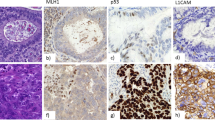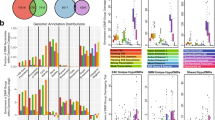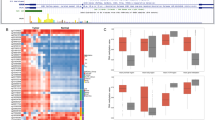Abstract
Silencing of the MLH1 gene by promoter hypermethylation is the mechanism underlying the microsatellite instability (MSI) phenotype in endometrial cancers. However, the profile of CpG methylation in a wide range of MLH1 promoters in endometrial cancers and in the normal endometrium is largely unknown. The present study investigates the region 700 bp upstream of MLH1 covering 48 CpG sites using bisulfite sequencing. Methylation status was classified as full (over 80% of CpGs are methylated), partial (10–80%) or nonmethylation (less than 10%). Of 56 endometrioid endometrial cancers, 16 (29%) were fully methylated, 14 (25%) were partially methylated and 26 (46%) were Q1not methylated. Analyses of MLH1 by immunohistochemical means and of MSI revealed that the Q2degree, rather than region-specific methylation of CpG islands is critical for decreased MLH1 expression and the MSI phenotype. Among 12 patients with methylated cancers, five (42%) patients contained methylated promoters in their normal endometria with profiles similar to those of cancer lesions, and these were associated with the MSI phenotype. In contrast, only one of 31 (3%) normal endometria from patients without endometrial malignancies harbored methylated promoters. These findings suggest that hypermethylation of the MLH1 promoter is frequent in the histologically normal endometrium adjacent to cancers, supporting the notion that hypermethylation of mismatch repair genes is the initial step that triggers various genetic events in endometrial carcinogenesis.
This is a preview of subscription content, access via your institution
Access options
Subscribe to this journal
Receive 50 print issues and online access
$259.00 per year
only $5.18 per issue
Buy this article
- Purchase on Springer Link
- Instant access to full article PDF
Prices may be subject to local taxes which are calculated during checkout





Similar content being viewed by others
References
Bronner CE, Baker SM, Morrison PT, Warren G, Smith LG, Lescoe MK, Kane M, Earabino C, Lipford J, Lindblom A, Tannergard P, Bollag RJ, Godwin AR, Ward DC, Nordenskild MA, Kolodner R and Liskay RM . (1994). Nature, 368, 258–261.
Burks RT, Kessis TD, Cho KR and Hedrick L . (1994). Oncogene, 9, 1163–1166.
Deng G, Chen A, Hong J, Chae HS and Kim YS . (1999). Cancer Res., 59, 2029–2033.
Deng G, Chen A, Pong E and Kim YS . (2001). Oncogene, 20, 7120–7127.
Duggan B, Felix J, Muderspach L, Tourgeman D, Zheng J and, Shibata D . (1994). J. Natl. Cancer Inst., 86, 1216–1221.
Esteller M, Levine R, Baylin SB, Hedrick Ellenson L and Herman JG . (1998). Oncogene, 17, 2413–2417.
Esteller M, Catasus L, Matisa-Guiu X, Mutter GL, Prat J, Baylin SB and Herman J . (1999). Am. J. Pathol., 155, 1767–1772.
Esteller M, Corn PG, Baylin SB and Herman JG . (2001). Cancer Res., 61, 3225–3329.
Fishel R, Lescoe MK, Rao MRS, Copeland NG, Jenkins NA, Garber J, Kane M and Kolodner R . (1993). Cell, 75, 1027–1038.
Gurin CC, Federici MG, Kang L and Boyd J . (1999). Cancer Res., 59, 462–466.
Herman JG, Graff JR, Myohanen S, Nelkin BD and Baylin SB . (1996). Proc. Natl. Acad. Sci. USA, 93, 9821–9826.
Herman JG, Umar A, Polyak K, Graff JR, Ahuja N, Issa JP, Markowitz S, Willson JK, Hamilton SR, Kinzler KW, Kane MF, Kolodner RD, Vogelstein B, Kunkel TA and Baylin SB . (1998). Proc. Natl. Acad. Sci. USA, 95, 6870–6875.
Inoue M . (2001). Int. J. Gynecol. Cancer, 11, 339–348.
Ionov Y, Peinado MA, Malkhosyan S, Shibata D and Perucho M . (1993). Nature (Lond) 363, 558–561.
Katabuchi H, van Rees B, Lambers AR, Ronnett BM, Blazes MS, Leach FS, Cho KR and Hedrick L . (1995). Cancer Res., 55, 5556–5560.
Liu B, Nicolaides NC, Markowitz S, Willson JKV, Parsons RE, Jen J, Peltomaki P, de la Chapelle A, Hamilton SR, Kinzler KW and Vogelstein B . (1995). Nat. Genet., 9, 48–55.
Mutter GL, Lin MC, Fitzgerald JT, Kum JB, Baak JP, Lees JA, Weng LP and Eng C . (2000). J. Natl. Cancer Inst., 92, 924–930.
Mutter GL, Ince TA, Baak JP, Kust GA, Zhou XP and Eng C . (2001). Cancer Res., 61, 4311–4314.
Nakagawa H, Nuovo GJ, Zervos EE, Martin Jr EW, Salovaara R, Aaltonen LA and de la Chapelle A . (2001). Cancer Res., 61, 6991–6995.
Papadopoulos N and Lindblom A . (1997). Hum. Mutat., 10, 89–99.
Peltomaki P and de la Chapelle A . (1997). Adv. Cancer Res., 71, 93–119.
Simpkins SB, Bocker T, Swisher EM, Mutch DG, Gersell DJ, Kovatich AJ, Palazzo JP, Fishel R and Goodfellow PJ . (1999). Hum. Mol. Genet., 8, 661–666.
Tashiro H, Blazes MS, Wu R, Cho KR, Bose S,, Wang SI, Li J, Parsons R and Ellenson LH . (1997). Cancer Res., 57, 3935–3940.
Thibodeau SN, Bren G and Schaid D . (1993). Science, 260, 816–819.
Toyota M, Ahuja N, Ohe-Toyota M, Herman JG, Baylin SB and Issa JP . (1999a). Proc. Natl. Acad. Sci. USA, 96, 8681–8686.
Toyota M, Ahuja N, Suzuki H, Itoh F, Ohe-Toyota M, Imai K, Baylin SB and Issa JP . (1999b). Cancer Res., 59, 5438–5442.
Zhou XP, Kuismanen S, Nystrom-Lahti M, Peltomaki P and Eng C . (2002). Hum. Mol. Genet., 11, 445–450.
Acknowledgements
We are grateful to Dr Miki Nakajima, Division of Drug Metabolism, Faculty of Pharmaceutical Sciences, Kanazawa University for helpful discussions and suggestions. This study was supported in part by Foundation for Promotion of Cancer Research, Kanzawa Medical Research Foundation and a Grant-in Aid for the Second Term Comprehensive 10-year Strategy for Cancer Control from the Ministry of Health and Welfare, Japan.
Author information
Authors and Affiliations
Corresponding author
Rights and permissions
About this article
Cite this article
Kanaya, T., Kyo, S., Maida, Y. et al. Frequent hypermethylation of MLH1 promoter in normal endometrium of patients with endometrial cancers. Oncogene 22, 2352–2360 (2003). https://doi.org/10.1038/sj.onc.1206365
Received:
Revised:
Accepted:
Published:
Issue Date:
DOI: https://doi.org/10.1038/sj.onc.1206365
Keywords
This article is cited by
-
Minimal microsatellite shift in microsatellite instability high endometrial cancer: a significant pitfall in diagnostic interpretation
Modern Pathology (2019)
-
hMLH1 promoter hypermethylation and MSI status in human endometrial carcinomas with and without metastases
Clinical & Experimental Metastasis (2012)
-
Effects of tamoxifen on the endometrium and its mechanism of carcinogenicity
Human Cell (2011)
-
5-Aza-2′-deoxycytidine is a potent inhibitor of DNA methyltransferase 3B and induces apoptosis in human endometrial cancer cell lines with the up-regulation of hMLH1
Medical Oncology (2010)



